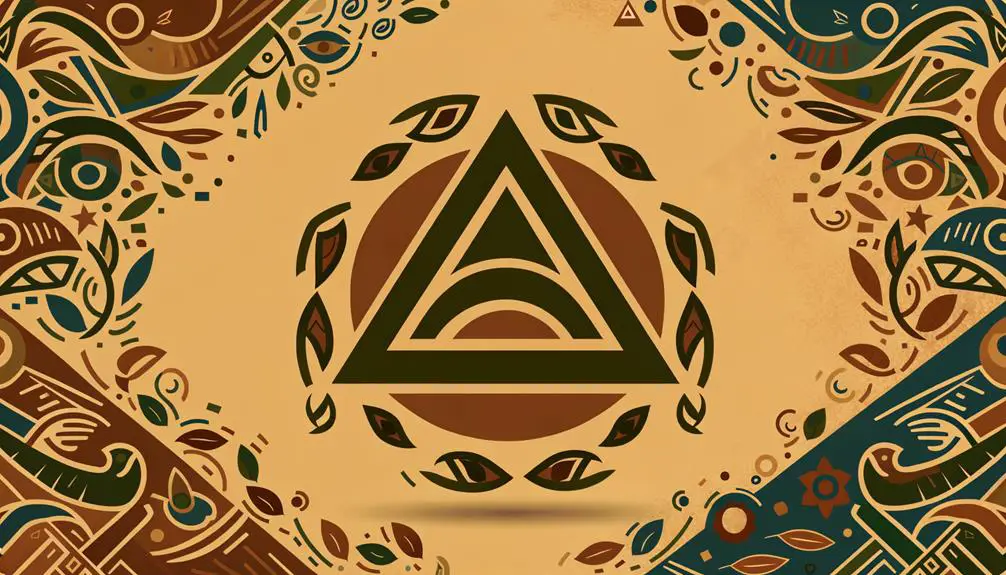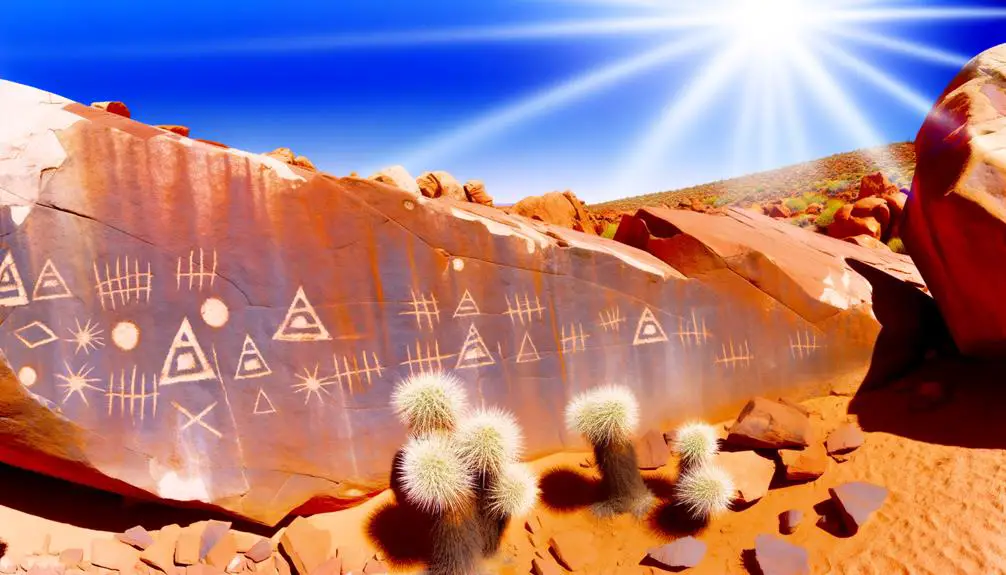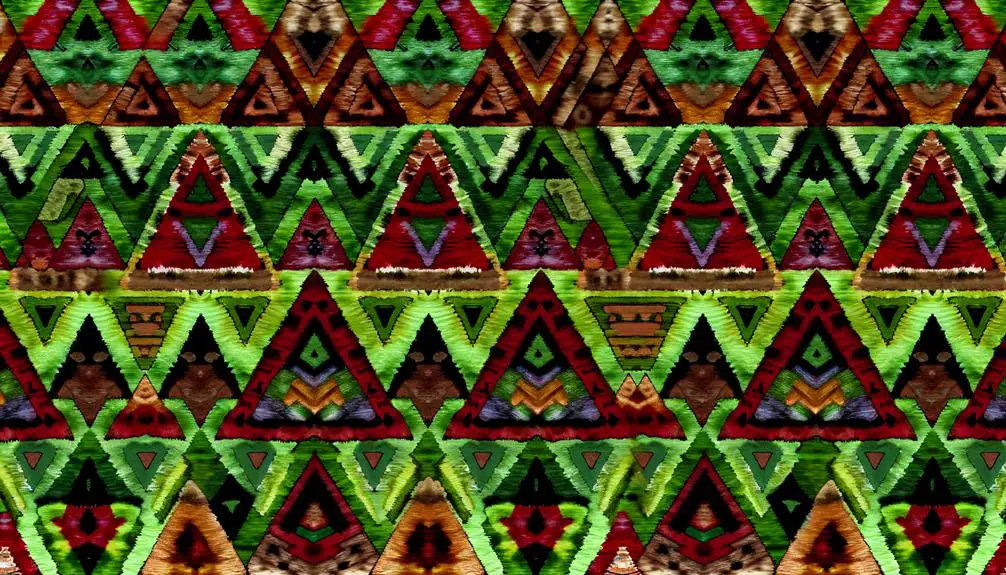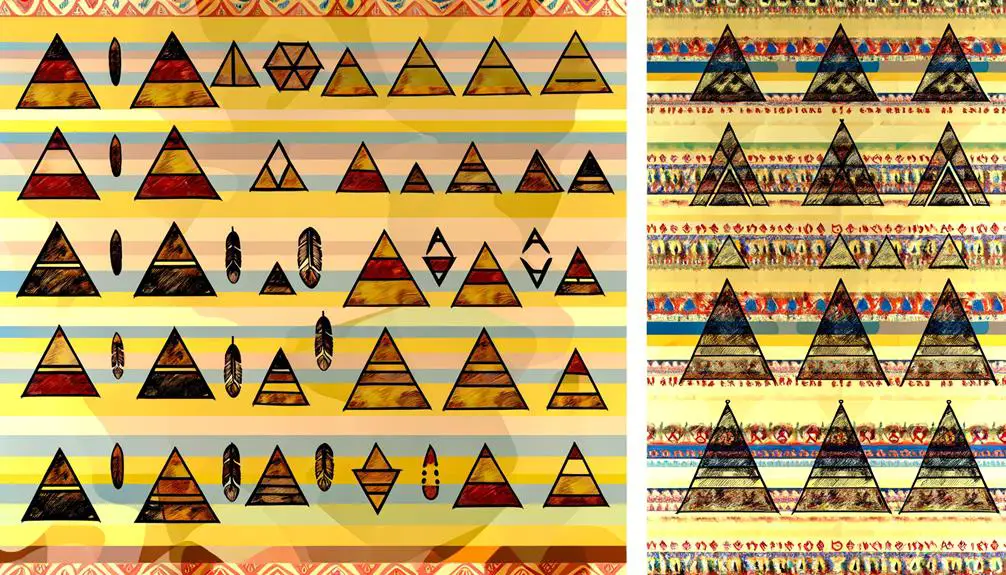Exploring the Meaning of Native American Triangle Symbols: A How-To Guide
The triangle symbol in Native American cultures symbolizes profound spiritual, cultural, and cosmological aspects. It represents balance and harmony, with its apex signifying ascension towards higher knowledge.
Tribes like the Hopi associate it with sacred mountains, while the Navajo view it as a connection between earth, sky, and humans. The Lakota interpret the triangle as the stages of life: birth, growth, and death.
Additionally, the triangle embodies the triad of mind, body, and spirit, emphasizing equilibrium. Each tribe's interpretation offers a unique cultural context, enriching our understanding of its multifaceted meanings.
Discovering more reveals deeper insights.

Key Takeaways
- The triangle symbolizes balance and harmony in many Native American cultures.
- It represents the stages of life: birth, growth, and death.
- The triangle connects Earth, Sky, and Humanity, emphasizing equilibrium.
- Different tribes have unique interpretations: Hopi, Navajo, Lakota, Cherokee, and Zuni.
- Modern uses include art, spiritual practices, cultural identity, education, and commercial branding.
Historical Background

Historically, how has the triangle symbol been represented and interpreted within various Native American cultures?
The triangle, often seen in artifacts, textiles, and rock art, is imbued with multifaceted meanings. In numerous Native American societies, it is viewed as a representation of balance and harmony, reflecting the interconnectedness of the earth, sky, and human existence.
Such geometrical forms were not merely decorative but carried profound spiritual and cultural significance. The triangle's apex often symbolized ascension towards higher knowledge or spiritual enlightenment. Additionally, its three sides could denote the sacred triad of life stages: birth, life, and death.
This geometric shape served as an essential element in conveying narratives, beliefs, and cosmology, deeply rooted in the cultural fabric of Native American heritage.
Symbolism Across Tribes
The triangle symbol holds varied meanings across different Native American tribes, reflecting a rich tapestry of cultural interpretations.
Among the Hopi, it is often associated with the concept of balance and harmony, while the Navajo may view it as a representation of foundational elements in their cosmology.
Understanding these diverse tribal interpretations requires contextual insight into each tribe's unique cultural and symbolic significance.
Diverse Tribal Interpretations
While the triangle symbol holds a fundamental significance across various Native American tribes, its specific meanings and contextual interpretations can vary widely, reflecting the rich diversity and unique cultural practices of each tribe. These interpretations are deeply rooted in the tribes' historical, geographical, and spiritual contexts.
- Navajo: Often represents the concept of balance and harmony within the universe.
- Apache: Symbolizes the three stages of life: birth, life, and death.
- Sioux: Utilizes the triangle in their star quilt patterns, signifying protection and guidance.
- Hopi: Indicates directional elements, often pointing to the cardinal directions.
- Cherokee: Represents the sacred number three, embodying the unity of mind, body, and spirit.
Understanding these diverse interpretations requires a nuanced appreciation of each tribe's unique cultural ethos.
Cultural Symbolic Significance
Building on the diverse tribal interpretations, the cultural symbolic significance of the triangle symbol across Native American tribes reveals layers of meaning that are deeply intertwined with each tribe's cosmology, rituals, and socio-cultural frameworks.
For the Navajo, the triangle often symbolizes the connection between earth, sky, and human beings, reflecting a tripartite cosmological balance.
Among the Lakota, it can represent the three stages of life: birth, growth, and death, emphasizing continuity and cyclical existence.
In Hopi traditions, triangles are integral to kiva murals, symbolizing sacred mountains and spiritual journeys.
This ethnographic perspective highlights how the triangle's multifaceted symbolism serves as a conduit for expressing complex cultural narratives and spiritual beliefs, underscoring its significance across various tribes.
Earth, Sky, Humanity

In Native American symbolism, the triangle often represents a profound connection between the elements of Earth, Sky, and Humanity, encapsulating the interdependent relationship and balance that these cultures hold sacred. This triadic relationship is deeply rooted in Native American cosmology, where each element plays a vital role:
- Earth: Symbolizes the physical domain and sustenance, grounding humanity.
- Sky: Represents the spiritual and celestial, providing guidance and wisdom.
- Humanity: Acts as the intermediary, embodying the connection between Earth and Sky.
- Balance: Emphasizes the equilibrium required to maintain harmony in life.
- Interdependence: Highlights the interconnectedness and mutual reliance of all elements.
Understanding this symbolism offers a window into Native American worldviews, illustrating a holistic approach to existence that values harmony with nature and the cosmos.
Mind, Body, Spirit
The Native American concept of the triangle also extends to the triad of Mind, Body, and Spirit, reflecting a holistic vision of human existence where each aspect is essential to overall well-being and harmony.
This triadic relationship emphasizes balance and interconnectedness, integral to many Native American cultures. The Mind represents knowledge and wisdom, the Body signifies physical health and actions, while the Spirit embodies spiritual beliefs and emotional well-being.
This sacred triad underscores a thorough approach to life, where neglecting any one aspect disrupts the natural equilibrium. Ethnographically, this perspective is evident in traditional practices such as healing rituals, which aim to restore balance across all three facets, emphasizing their interdependence and the community's commitment to holistic health.
Artistic Representations

Reflecting the triadic relationship of Mind, Body, and Spirit, Native American artistic representations frequently incorporate the triangle symbol to convey deeper meanings and cultural narratives. This geometric form appears in various artistic mediums, each embodying significant cultural elements. The triangle's usage spans across different tribes, each integrating unique interpretations and styles.
Key representations include:
- Textiles: Intricate patterns in blankets and clothing.
- Pottery: Decorative motifs adorning ceremonial vessels.
- Beadwork: Symbolic designs on jewelry and attire.
- Totem Poles: Carvings that include triangular shapes symbolizing familial and spiritual connections.
- Sand Paintings: Temporary artworks used in healing ceremonies.
Through these artistic forms, the triangle serves as a visual lexicon, articulating profound aspects of Native American cosmology and identity.
Spiritual Significance
Across various Native American tribes, the triangle symbol holds profound spiritual significance, often representing the sacred interconnectedness of life, the earth, and the cosmos. This geometric form is frequently interpreted as a reflection of the triadic structure of existence: the physical, the spiritual, and the celestial.
In many traditions, the upward-pointing triangle signifies aspirations towards higher spiritual domains, while the downward-pointing triangle denotes grounding and connection to the earth. The convergence of these directional forces within the triangle encapsulates the balance and harmony inherent in the universe.
Ethnographic studies reveal that this symbol is deeply embedded in ritualistic practices, embodying the unity of natural and spiritual worlds, guiding individuals in their spiritual journeys and communal cohesion.
Cultural Variations

Cultural variations in the interpretation of the triangle symbol among Native American tribes reveal a complex tapestry of meanings shaped by regional influences and unique tribal traditions.
For instance, the triangle might signify the sacred mountain in one region, while another tribe could use it to represent familial lineage or social hierarchy.
Examining these regional symbol interpretations and tribal design differences enriches our understanding of how diverse cultural contexts influence symbolic language.
Regional Symbol Interpretations
How does the interpretation of the triangle symbol vary across different Native American tribes, offering a rich tapestry of cultural significance and regional diversity?
The triangle symbol's meaning is deeply embedded in the unique cosmologies and worldviews of individual tribes.
For example, among the Hopi, triangles often represent the three worlds of the Sun Father, while the Navajo use them to signify mountains and the concept of balance.
Hopi: Symbolizes the three domains of the Sun Father.
Navajo: Represents mountains and equilibrium.
Lakota: Triangles can denote the sacred number three and its spiritual significance.
Cherokee: Used in storytelling, symbolizing stages of life.
Zuni: Often linked to rain and fertility.
This rich diversity underscores the profound and varied cultural contexts within which the triangle symbol operates.
Tribal Design Differences
While the symbolic meanings of the triangle vary among tribes, the specific designs and artistic expressions of these symbols further highlight the distinctive cultural variations and aesthetic principles inherent to each Native American community. From the geometric precision of the Navajo to the organic fluidity of the Haida, each tribe's representation of the triangle carries unique cultural significance. This differentiation not only reflects diverse artistic traditions but also embodies the spiritual and social values of each group.
| Tribe | Design Characteristics | Cultural Significance |
|---|---|---|
| Navajo | Geometric precision | Harmony and balance |
| Haida | Organic fluidity | Connection to nature |
| Hopi | Symmetrical patterns | Spiritual protection |
| Lakota | Bold, simple triangles | Strength and resilience |
| Zuni | Intricate, interwoven shapes | Community interconnectedness |
Modern Interpretations
In contemporary contexts, the triangle symbol, once intrinsic to various Native American traditions, has evolved to encompass a broader range of interpretations and applications. This evolution reflects both the dynamic nature of cultural symbols and the influences of modernity on indigenous identities and expressions.
Key modern interpretations include:
- Artistic Expressions: Utilized in contemporary Native American art, blending traditional and modern aesthetics.
- Spiritual Significance: Adopted in various spiritual practices, symbolizing balance and connection to nature.
- Cultural Identity: Employed as a marker of cultural pride and heritage in jewelry and clothing.
- Educational Tools: Incorporated in educational materials to teach about Native American history and symbology.
- Commercial Use: Appearing in branding and design, often to evoke authenticity and connection to indigenous cultures.
This multifaceted usage underscores the triangle symbol's enduring relevance.
Conclusion
The Native American triangle symbol, a multifaceted emblem, encapsulates a wealth of meanings across different tribes, reflecting profound connections to Earth, sky, and humanity, as well as mind, body, and spirit.
Its artistic representations serve as a canvas of cultural expression, while its spiritual significance resonates deeply within indigenous cosmologies.
Despite cultural variations, the triangle's essence remains a beacon of unity and continuity.
Modern interpretations continue to revere and adapt this ancient symbol, embodying a bridge between past and present.






